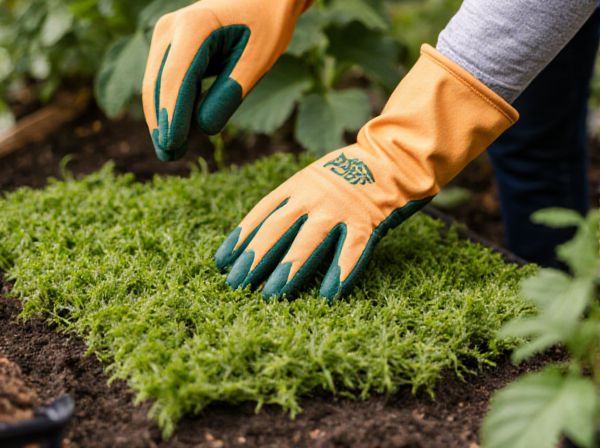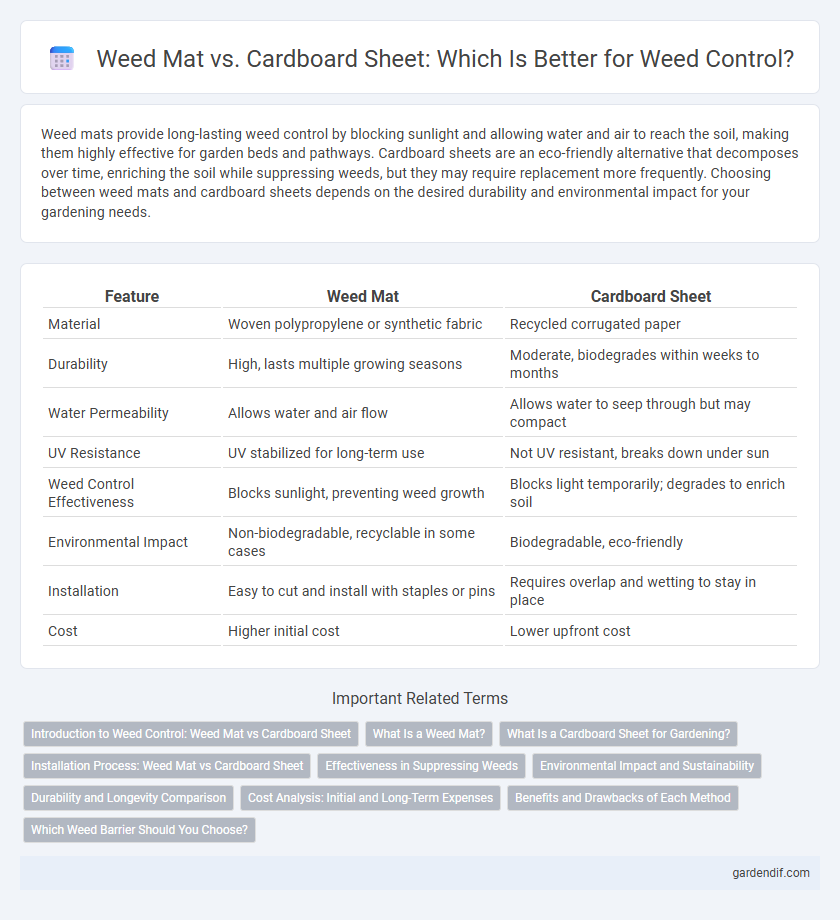
Weed mat vs Cardboard sheet Illustration
Weed mats provide long-lasting weed control by blocking sunlight and allowing water and air to reach the soil, making them highly effective for garden beds and pathways. Cardboard sheets are an eco-friendly alternative that decomposes over time, enriching the soil while suppressing weeds, but they may require replacement more frequently. Choosing between weed mats and cardboard sheets depends on the desired durability and environmental impact for your gardening needs.
Table of Comparison
| Feature | Weed Mat | Cardboard Sheet |
|---|---|---|
| Material | Woven polypropylene or synthetic fabric | Recycled corrugated paper |
| Durability | High, lasts multiple growing seasons | Moderate, biodegrades within weeks to months |
| Water Permeability | Allows water and air flow | Allows water to seep through but may compact |
| UV Resistance | UV stabilized for long-term use | Not UV resistant, breaks down under sun |
| Weed Control Effectiveness | Blocks sunlight, preventing weed growth | Blocks light temporarily; degrades to enrich soil |
| Environmental Impact | Non-biodegradable, recyclable in some cases | Biodegradable, eco-friendly |
| Installation | Easy to cut and install with staples or pins | Requires overlap and wetting to stay in place |
| Cost | Higher initial cost | Lower upfront cost |
Introduction to Weed Control: Weed Mat vs Cardboard Sheet
Weed mats provide a durable, breathable barrier that effectively blocks sunlight to prevent weed growth while allowing water and air to reach plants. Cardboard sheets offer an eco-friendly, biodegradable alternative that suppresses weeds by creating a thick, natural mulch layer but may require more frequent replacement. Both methods reduce soil erosion and improve moisture retention, making them essential tools in sustainable weed control practices.
What Is a Weed Mat?
A weed mat is a durable, permeable fabric designed to suppress weed growth while allowing water and nutrients to reach plant roots, outperforming cardboard sheets in longevity and effectiveness. Unlike cardboard sheets that decompose quickly and require frequent replacement, weed mats provide long-term weed control with minimal maintenance. Their UV resistance and breathability make weed mats an ideal choice for sustainable gardening and landscaping projects.
What Is a Cardboard Sheet for Gardening?
A cardboard sheet for gardening serves as an effective weed barrier by blocking sunlight and suppressing weed growth while gradually decomposing to enrich the soil. Unlike weed mats made of synthetic materials, cardboard is biodegradable, eco-friendly, and allows moisture retention, promoting healthier plant development. Gardeners often use cardboard sheets beneath mulch to improve soil structure and reduce the need for chemical herbicides.
Installation Process: Weed Mat vs Cardboard Sheet
Weed mats offer a straightforward installation process by simply rolling them out over the soil and securing with landscape staples, ensuring long-term weed suppression and durability. Cardboard sheets require layering and overlapping to fully cover the area, followed by wetting to help them conform and break down naturally, which can be more labor-intensive and time-consuming. While weed mats provide quicker setup and immediate barrier effectiveness, cardboard sheets excel in biodegradability but often demand more meticulous placement and maintenance during installation.
Effectiveness in Suppressing Weeds
Weed mats provide superior effectiveness in suppressing weeds by blocking sunlight and allowing water and air to pass through, promoting healthy plant growth while preventing weed germination. Cardboard sheets also suppress weeds by creating a physical barrier, but they tend to degrade faster and may allow weed seeds to penetrate if not properly secured. Choosing weed mats often results in longer-lasting weed control and reduced maintenance compared to using cardboard as a weed barrier.
Environmental Impact and Sustainability
Weed mats offer superior environmental benefits compared to cardboard sheets due to their durability and reusability, reducing the need for frequent replacement and waste generation. Unlike cardboard sheets that decompose rapidly and require frequent disposal, weed mats limit soil erosion and maintain soil health by allowing water and air penetration while suppressing weed growth. Sustainable landscaping practices favor weed mats as they minimize landfill contributions and reduce the demand for raw materials, supporting long-term eco-friendly gardening solutions.
Durability and Longevity Comparison
Weed mats are made of durable woven or non-woven polypropylene, offering enhanced resistance to tearing, UV exposure, and moisture compared to cardboard sheets, which degrade quickly when wet and break down under prolonged sunlight. The longevity of weed mats typically spans multiple growing seasons, maintaining effective weed suppression, while cardboard sheets often require replacement after a single season due to their biodegradable nature. Choosing weed mats ensures sustained durability and consistent performance for long-term garden maintenance.
Cost Analysis: Initial and Long-Term Expenses
Weed mats typically cost more initially than cardboard sheets but offer greater durability and reusability, reducing replacement frequency and long-term expenses. Cardboard sheets are cheaper upfront but degrade quickly, requiring frequent replacement that increases ongoing costs. Evaluating the total cost of ownership, weed mats provide better value over time for sustained weed control in landscaping or gardening projects.
Benefits and Drawbacks of Each Method
Weed mats provide effective weed suppression by allowing water and nutrients to penetrate while blocking sunlight, reducing the need for chemical herbicides and minimizing soil erosion; however, they may degrade over time and require proper installation to avoid gaps. Cardboard sheets offer an eco-friendly, biodegradable option that enriches soil as they decompose and are cost-effective for large-scale applications, but they can retain moisture excessively and may be less durable in heavy rainfall or extended growing seasons. Choosing between weed mat and cardboard sheets depends on factors like environmental impact, longevity, and specific garden conditions.
Which Weed Barrier Should You Choose?
Weed mats offer superior durability and UV resistance compared to cardboard sheets, making them ideal for long-term weed control in gardens and landscapes. Cardboard sheets are biodegradable and eco-friendly but tend to break down quickly, requiring more frequent replacement. For a balance of effectiveness and environmental impact, choose weed mats for lasting protection or cardboard sheets for short-term, natural mulch solutions.
Weed mat vs Cardboard sheet Infographic

 gardendif.com
gardendif.com